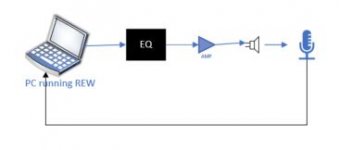Member
Joined 2003
Distortion measured by software like REW includes distortion products of all devices in the audio chain as in your photo. From PC to speaker and even the mic itself. It's just that the distortion products measured are usually dominated by what is generated by the speaker.
No, it won't show up as harmonic distortion. This is a different kind of distortion, one that shows as a response plot that isn't flat. Sometimes, EQ is all that is needed to reduce this distortion.
Frequency equalization theoretically does not produce frequencies not in the signal,
(which would be nonlinear distortion). So frequency equalization is termed linear distortion,
since linear operations cannot produce different frequencies.
(which would be nonlinear distortion). So frequency equalization is termed linear distortion,
since linear operations cannot produce different frequencies.
Last edited:
Member
Joined 2003
No, it won't show up as harmonic distortion. This is a different kind of distortion, one that shows as a response plot that isn't flat. Sometimes, EQ is all that is needed to reduce this distortion.
In an ideal world EQ is linear distortion only, non-linear distortion is not generated. In the real world...EQ as a separate piece of hardware may be DSP with ADC and DAC and sample rate conversions, or may be analog with many transistors and caps to pass the signal through. Then there's potential for clipping signal from applying boost without lowering overall gain which absolutely will show up as harmonic distortion.
In any case, if the source is a PC then there is no need to use external hardware for EQ, just use EQ APO or some other EQ software.
THD stands for total harmonic distortion, which means the generation of frequencies not in the original signal. Equalization is an amplitude adjustment of existing frequencies. This may modify the phase relationship between existing frequencies, which some people may call phase distortion, but equalization is intended to correct amplitude and phase response of speakers (etc). However just moving your head around in a live performance has similar effects so there is no such thing as "perfect" response. If you like what you hear then all is good. Don't worry about correctness.
Thanks for the responses. The distortion I'm seeing in REW is from me using too much gain in my EQ settings and causing distortion. Lowering the gain cleared up the distortion.
This is a great observation 🙂Thanks for the responses. The distortion I'm seeing in REW is from me using too much gain in my EQ settings and causing distortion. Lowering the gain cleared up the distortion.
Far to many people forget that something that looks so easy in the digital domain/software - still has to be translated into the analogue domain, before we can hear it. And there are indeed many adjustments done in DSP's, that might try and reduce an audio issue - but at the same time introduce an all new one or amplify a previous non-issue.
Glad you found out what was going on

- Home
- Design & Build
- Software Tools
- Is equalization distortion?
